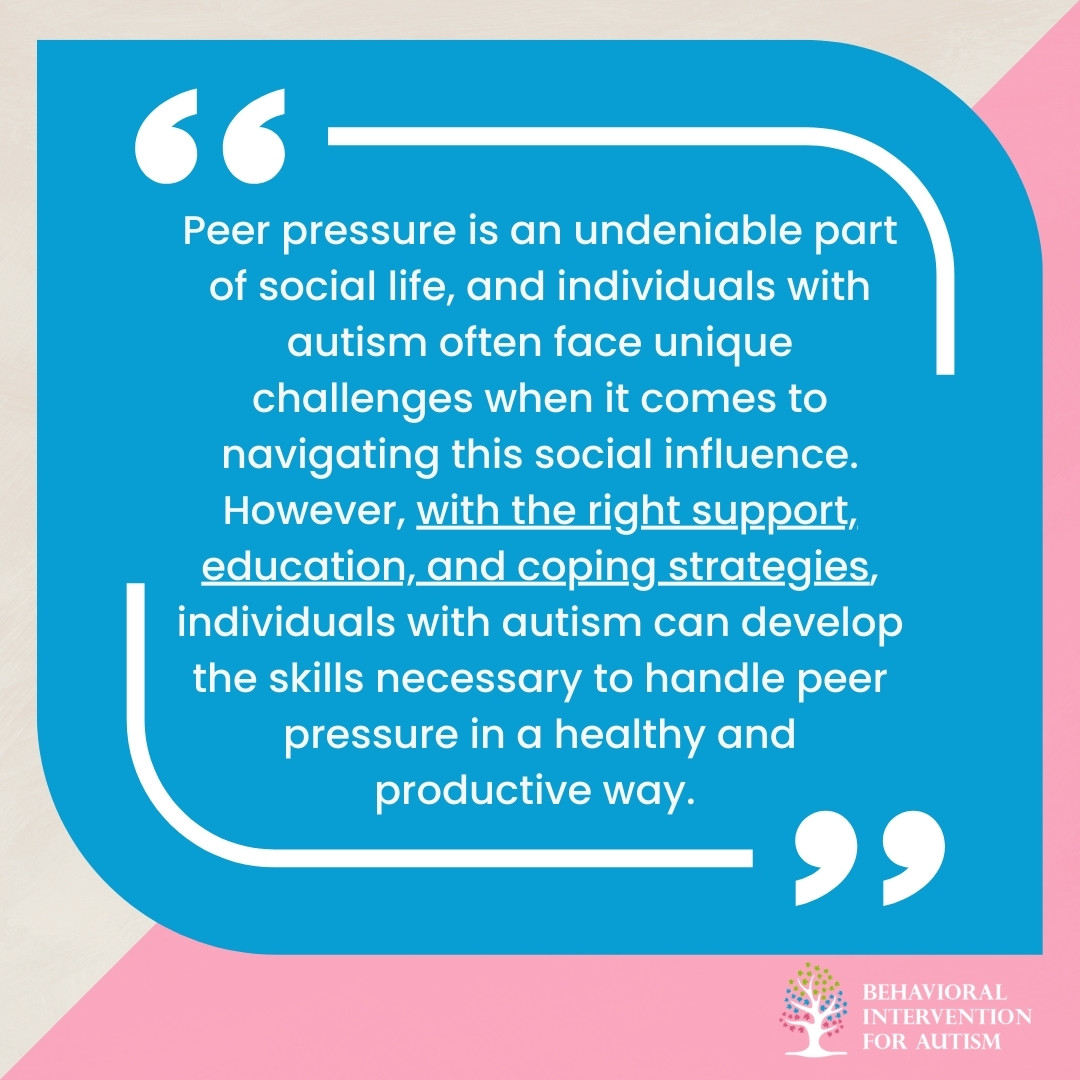
Table of Contents
Peer pressure is a powerful force in the lives of children and adults alike, influencing their choices, behavior, and social interactions. However, for individuals on the autism spectrum, the impact of peer pressure can be even more pronounced. Autism Spectrum Disorder (ASD) affects social skills, communication, and understanding social cues, which can make navigating peer interactions more complex. In this article, we will explore how peer pressure affects those with autism, the unique challenges they face, and strategies for managing these pressures in a healthy and supportive way.
What is Peer Pressure?
Peer pressure refers to the influence that a person’s peers (friends, classmates, or colleagues) have on their behavior, beliefs, or actions. This influence can either be positive, such as encouraging someone to study harder, support their mental health, or engage in healthy activities, or negative, such as encouraging harmful behaviors like smoking, drinking, or engaging in risky activities.
For most people, peer pressure is a normal part of social development. Children and teenagers, in particular, are highly sensitive to the opinions of their peers, and their desire to fit in can lead them to adopt certain behaviors. For individuals with autism, however, the ability to navigate peer pressure can be more challenging due to difficulties with social understanding, communication, and interpreting non-verbal cues.
Peer Pressure in Children with Autism
Children with autism often experience heightened challenges in social interactions. Their difficulty in reading body language, understanding tone of voice, or recognizing social norms can make them more vulnerable to peer pressure. Additionally, many children on the autism spectrum are more eager to please others and avoid conflict, which can sometimes lead them to give in to peer pressure, even when the behavior goes against their personal preferences or values.
Social interaction requires a variety of skills, including turn-taking in conversation, reading facial expressions, and responding to social cues. Children with autism may struggle with these aspects of communication, which can make them feel isolated and, at times, susceptible to peer influence. Their desire for connection with others, combined with difficulties in social interaction, can create a situation where peer pressure can have a stronger influence.
The Role of Social Media and Peer Pressure
In today’s digital age, social media plays a significant role in shaping the social dynamics of children and teenagers. Peer pressure is not confined to in-person interactions but extends to online platforms like Instagram, TikTok, and Facebook. For individuals with autism, this online world can present additional challenges.
While the internet provides valuable opportunities for social interaction and learning, it also introduces new forms of peer pressure. Social media can promote unrealistic standards of behavior, appearance, and social engagement, leading to feelings of inadequacy or stress in individuals with autism. The pressure to conform to social norms online can be even more difficult for those with autism, who may already struggle with understanding the intricacies of social interactions.
How Peer Pressure Affects Individuals with Autism
The impact of peer pressure on individuals with autism varies depending on the severity of the disorder, the individual’s age, and their level of social functioning. However, there are some common ways in which peer pressure can affect individuals on the autism spectrum.
Emotional Distress
One of the most significant consequences of peer pressure on individuals with autism is emotional distress. Children and adults with autism may experience feelings of confusion, anxiety, and frustration when trying to fit in with their peers. The constant effort to understand and meet social expectations can lead to stress, which may manifest in behavioral issues or emotional outbursts.
In situations where individuals with autism feel they cannot meet peer expectations, they may withdraw socially or display signs of depression and loneliness. This emotional toll can significantly affect their self-esteem and overall mental well-being.
Misinterpretation of Social Cues
Individuals with autism often struggle to interpret non-verbal cues, such as body language, tone of voice, and facial expressions. This difficulty can lead to misunderstandings in social situations, where they may misread the intentions of their peers. As a result, they might be more easily manipulated or coerced into actions they wouldn’t otherwise consider.
For example, a child with autism may not recognize when a peer is joking or teasing and might feel compelled to go along with behaviors they do not fully understand. This misunderstanding can exacerbate feelings of confusion and anxiety, especially when the individual does not realize they are being influenced by peer pressure.
Difficulty Saying “No”
Another challenge individuals with autism face in relation to peer pressure is difficulty asserting themselves or saying “no.” Many individuals on the autism spectrum have a strong desire for acceptance and may struggle with conflict resolution. As a result, they may go along with what their peers want, even if it makes them uncomfortable or goes against their personal values.
The difficulty in setting boundaries and expressing discomfort can make it harder for individuals with autism to navigate peer pressure in healthy ways. For example, they may find it challenging to refuse invitations to participate in activities that they find overwhelming or distressing, such as going to a crowded party or engaging in risky behaviors.
Supporting Individuals with Autism in Handling Peer Pressure
While peer pressure can present unique challenges for individuals with autism, there are strategies that can help them build resilience and improve their ability to navigate social situations.
1. Building Social Skills
One of the most effective ways to support individuals with autism in managing peer pressure is to help them develop strong social skills. Social skills training can teach individuals how to recognize social cues, respond to peers appropriately, and understand the context of social situations. With these skills, individuals with autism may feel more confident and capable of handling peer pressure when it arises.
For example, teaching a child with autism how to recognize when a peer is joking versus being serious can help them avoid being manipulated. Role-playing exercises and social skills groups can be useful tools in this regard, allowing individuals to practice different social scenarios in a safe, supportive environment.
2. Encouraging Self-Advocacy
Encouraging individuals with autism to advocate for themselves can help them feel more empowered and confident when faced with peer pressure. Teaching self-advocacy skills involves helping individuals identify their needs, express their preferences, and set boundaries in social situations. By practicing assertiveness, individuals with autism can learn how to confidently say “no” when necessary and communicate their desires without fear of judgment.
Self-advocacy also involves helping individuals understand their rights in social situations, such as the right to be treated with respect and the right to make choices about their own behavior. By fostering a sense of autonomy, individuals with autism can better navigate peer pressure and social interactions.
3. Building Supportive Friendships
A strong support network of friends and family can play a crucial role in helping individuals with autism navigate peer pressure. Encouraging friendships with individuals who share similar interests and values can provide a sense of security and belonging. Positive friendships can also offer emotional support and help individuals with autism develop the confidence to resist negative peer pressure.
Additionally, parents, teachers, and caregivers can serve as role models and provide guidance on how to handle social situations. When individuals with autism have access to trustworthy and understanding peers, they are less likely to fall victim to harmful influences.
4. Teaching Coping Mechanisms
Coping mechanisms are essential tools for managing the emotional distress that can arise from peer pressure. Teaching individuals with autism how to cope with stress, anxiety, and frustration can help them maintain their emotional well-being. Some effective coping mechanisms include deep breathing exercises, mindfulness practices, and journaling.
By learning how to manage their emotions, individuals with autism can better handle stressful social situations and reduce the likelihood of reacting impulsively to peer pressure. Additionally, coping mechanisms can help individuals build resilience, making it easier for them to bounce back from challenging experiences.

Reach Out for Support Today
Peer pressure can be challenging for individuals with autism, often leading to stress or confusion in social situations. Understanding how to navigate these pressures is key to fostering confidence and resilience. Through tailored strategies, we empower individuals with the tools they need to manage peer interactions and make informed decisions. Our ABA programs in Florida are designed to provide personalized support, helping individuals develop vital social skills and emotional regulation. Behavioral Intervention For Autism is committed to offering the highest quality ABA therapy services, ensuring each person receives the care and attention they deserve. Contact us now to see how we can help!
Sources:
https://greatergood.com/blogs/news/peer-pressure
- 9 Common Obsessions of Children With Autism You Should Know - February 25, 2025
- What is Neurodiversity? A Guide to Embracing Differences - February 25, 2025
- Understanding Hyperfocus in Autism: What It Means and Why It Happens - February 25, 2025


